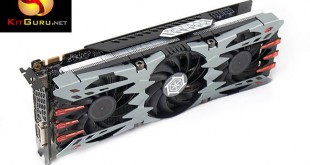
Today we look at the Inno3D GeForce GTX 960 iChill X3 Air Boss Ultra, one of the most ludicrously named graphics cards in history. This card ships with a monstrous cooling system which will need to perform at the top of its class if it is to justify the physical dimensions. Today we find out if the Inno3D card is delightfully delicious, or hideously horrific.
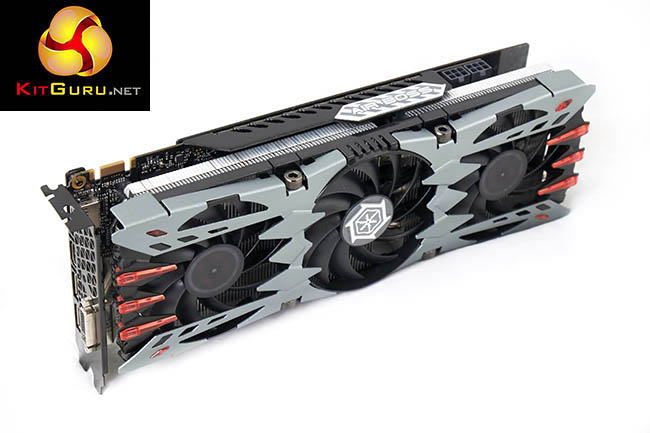
The Inno3D GeForce GTX 960 iChill X3 Air Boss Ultra is certainly distinctive in appearance, the sharp jutting edges remind me of a sadistic weapon that Jigsaw would use in a gory SAW flix. I can't say the appearance appeals to me, but in the world of hardware, beauty is firmly in the eye of the beholder.
For those interested, the ‘Air Boss’ name is a naval term used on the flight deck of an aircraft carrier. The Air Boss is in charge of all the operations of the flight deck from moving planes around and landing and launching aircraft. The Air Boss resides in the tower and communicates with the flight deck via a megaphone. Sure, its all slightly corny, but its nothing new as graphics card manufacturers try to come up with the next big product brand name.
Shorter names are more effective, a point which Inno3D have missed completely. We all remember the Nvidia GTX Titan brand name – would it have worked as well with a moniker such as Nvidia GTX Titan Mega Blaster Death Ray Ultimate Obliteration Edition? No, precisely.
How does the technology behind the GTX960 stack up?
| GPU | GeForce GTX 750ti (Maxwell) | GeForce GTX 960 (Maxwell) | Geforce GTX 970 (Maxwell) | GeForce GTX 980 (Maxwell) |
| Streaming Multiprocessors | 5 | 8 | 13 | 16 |
| CUDA Cores | 640 | 1024 | 1664 | 2048 |
| Base Clock | 1020 mhz | 1126 mhz | 1050 mhz | 1126 mhz |
| GPU Boost Clock | 1085 mhz | 1178 mhz | 1178 mhz | 1216 mhz |
| Total Video memory | 2GB | 2GB | 4GB | 4GB |
| Texel fill-rate | 40.8 Gigatexels/Sec | 72.1 Gigatexels/Sec | 109.2 Gigatexels/Sec | 144.1 Gigatexels/Sec |
| Memory Clock | 5400 mhz | 7010 mhz | 7000 mhz | 7000 mhz |
| Memory Bandwidth | 86.4 GB/sec | 112.16 GB/sec | 224 GB/s | 224 GB/sec |
| Bus Width | 128bit | 128bit | 256bit | 256bit |
| ROPs | 16 | 32 | 64 | 64 |
| Manufacturing Process | 28nm | 28nm | 28nm | 28nm |
| TDP | 60 watts | 120 watts | 145 watts | 165 watts |
Nvidia’s GTX960 GM206 ships with 1,024 CUDA cores – significantly more than the 640 CUDA cores available on the GTX750ti, but half the amount featured on the flagship GTX980 (2,048).
A bone of contention within the enthusiast audience will be the somewhat limited 128 bit memory interface – identical to the GTX750ti. Nvidia are keen to point out however that the Maxwell memory architecture is approximately 33% more efficient than Kepler. We do delve into this a little deeper on the architecture page later in the review.
Nvidia’s reference clock speeds are set at 1,126mhz (1,178mhz boost), with 32 ROPs and 64 texture units. Inno3D have enhanced the core speed to 1,329mhz – a considerable 18% overclock over reference. The GDDR5 memory is also slightly overclocked, running at 1,800mhz (7.2Gbps effective).
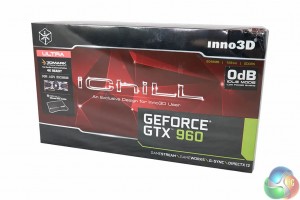
The Inno3D GeForce GTX 960 iChill X3 Air Boss Ultra ships in a rather large box with much of the real estate focus given to the ‘iChill' name.
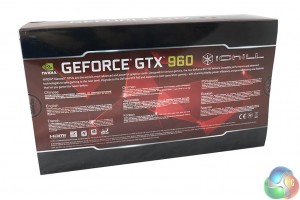
The rear of the box has overview text in various languages.
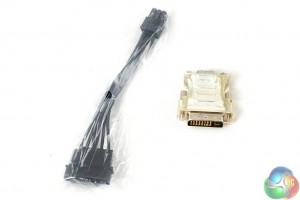
Inside a power and video converter. The retail version of this card should also ship with a mouse mat, according to the front of the box anyway.
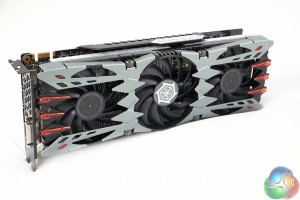
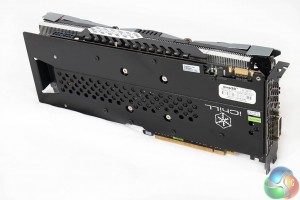
This is a hefty beast of a card, especially compared to other GTX960's we have reviewed. The cooler is aggressively styled, and some of the shroud sections can cut your finger, if you aren't careful. The rear of the card is fitted with a backplate, which scores bonus points.
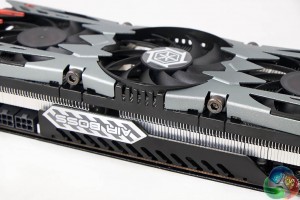
The fans can be removed with an allen key, ideal for easy access for cleaning.
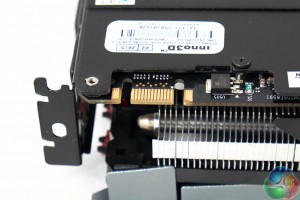
The GTX960 is SLi capable, with a single connector available – shown above.
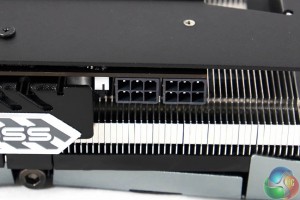
Nvidia's reference GTX960 takes power from a single 6 pin power connector. Inno3D have equipped this custom solution with two 6 pin power connectors. Normally this is to provide more power, and therefore stability under heavily overclocked situations.
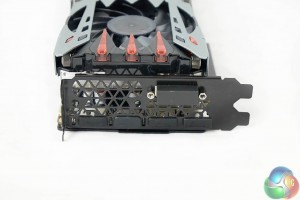
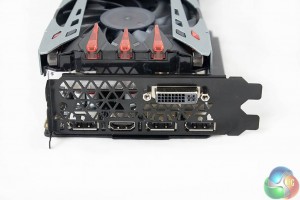
We love the mean black I/O plate fitted to the card, it even ships with black covers over the connectors. The card ships with a single DVI connector, and 3x full sized DisplayPort and 1x HDMI connector.
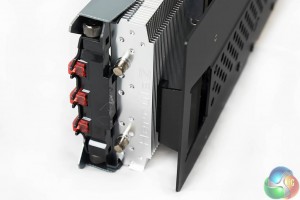
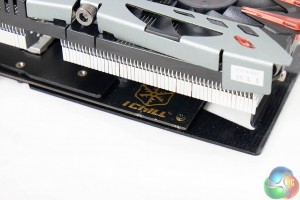
The heatsink is very large, and heavy.
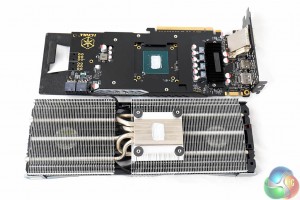
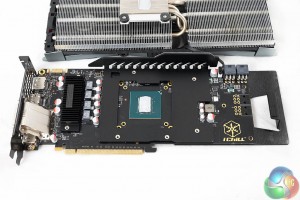
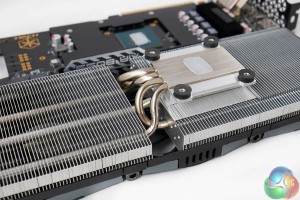
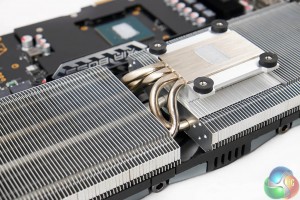
The cooler is impressive, there are thick nickel plated copper heatpipes running into two separate aluminum heatsinks on either side of the core.
The new GTX960 incorporates Nvidia's GM206 GPU. The GM206 features all the primary architectural innovations we discussed when the GTX980 launched last year. The Maxwell GPU uses a new SM design that has been designed to enhance efficiency.
The Maxwell SMM is partitioned into four 32 CUDA core processing blocks (128 CUDA cores per SM), and each of these has its own dedicated resources for instruction buffering and scheduling. Nvidia's design is based around keeping the GPU CUDA cores fully utilised more often to improve workload efficiency, and to reduce wasted power.

Each of the GM206 SMM units have their own 96kb shared memory, and the L1/texturing caching functions are combined into a 24kb pool of memory per pair of processing blocks (48kb per SMM). Previous Kepler GPU's had a smaller 64kb shared memory function which was also shared as a L1 cache.
Nvidia have calculated that each GM206 CUDA core can deliver 1.4 more performance per core compared to the GM106 Kepler core, with a 2x performance ratio per watt.
While many will negatively focus on the 128 bit memory interface of the new GTX960, Nvidia have added a new memory compression engine.
This third generation colour compression engine offers new modes for colour related compression which will have a positive impact on how the GPU effectively uses available memory bandwidth. Nvidia say that the GM206 uses approximately 25% fewer bytes per frame compared to previous generation Kepler products. Nvidia claim that the 128 bit, 7Gbps memory interface in GM206 is able to provide more bandwidth than its direct predecessor, the GK106. (148.8GB/sec effective in GTX 960 vs 144.2GB/sec in GTX 660).
The GTX960 will support resolutions up to 5k with up to four simultaneous displays, and support for up to four 4k MST displays. The card also fully supports HDMI 2.0.
While the GTX750ti seems an ideal partner for a media center build, Nvidia also claim in their literature that the GTX960 is a good choice for the same task. The GM206 has support for H.265 (HEVC) encoding and decoding. The GTX980 NVENC video engine offers native support for H.265 encode only, no decode. GM206 also fully supports HDCP 2.2 content protection over HDMI.
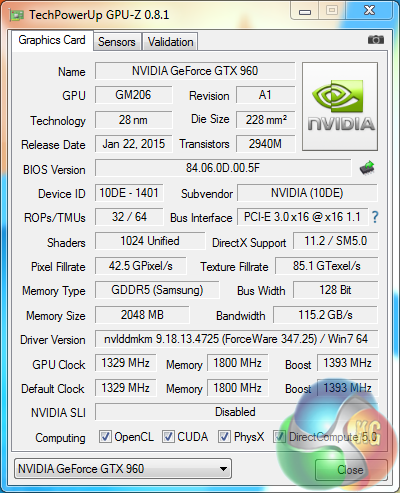
The Nvidia reference specifications are 1,125mhz (core) and 1,753mhz memory (7Gbps effective).
Inno3D have cranked the GM206 core on this card very highly, to a core clock speed of 1,329mhz – the highest we have tested yet. The Boost speed is running close to 1,400mhz out of the box, at 1,393mhz. The memory receives a boost to 1,800mhz (7.2Gbps effective) from 1,753mhz (7Gbps effective).
As the majority of our readers are likely to buy a GTX960 to run in a highly overclocked state, we felt we would get the overclocking section out of the way, first. Throughout this review we will run all tests with the Inno3D GeForce GTX 960 iChill X3 Air Boss Ultra at ‘out of box' speeds, as well as the maximum stable overclocks we were able to achieve.
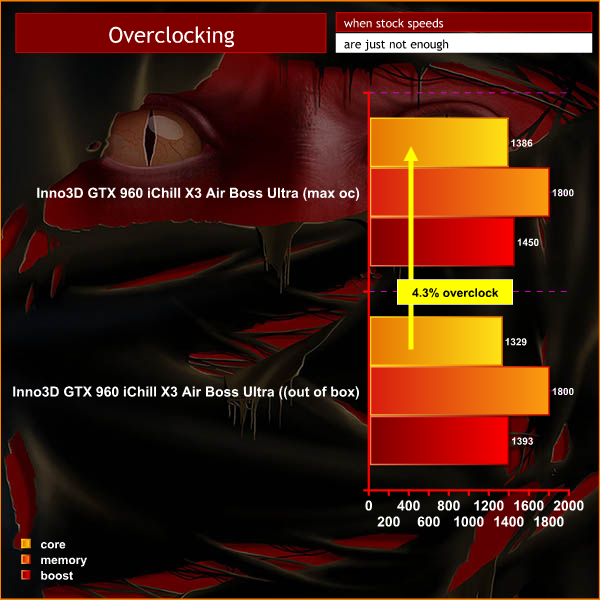
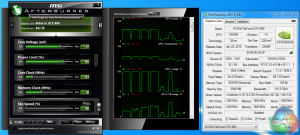
We managed to push the core to 1,386mhz, and the boost to 1,450mhz. This is close to a 4.3% increase over the overclocked speeds that the BIOS is coded to. This translates to a final enhanced clock speed of 23.2% over Nvidia reference speeds.
On this page we present some high resolution images of the product taken with a Fuji XT1 camera. These will take much longer to open due to the dimensions, especially on slower connections. If you use these pictures on another site or publication, please credit Kitguru.net as the owner/source.
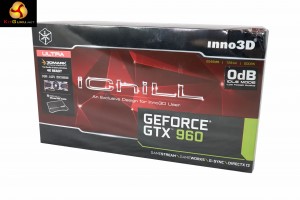
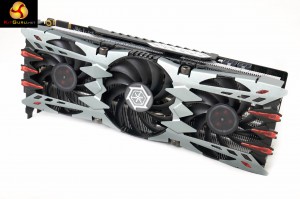
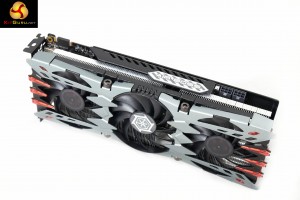
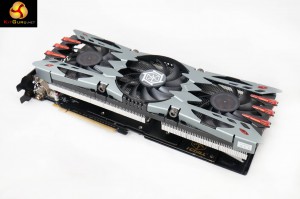
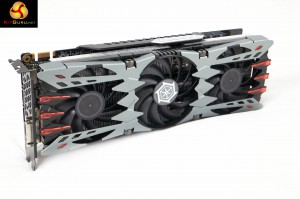
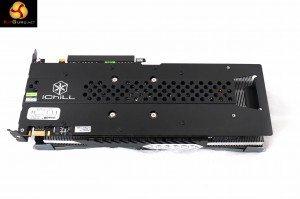
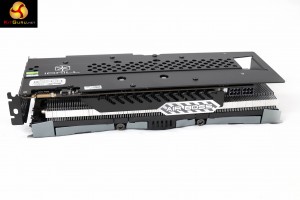
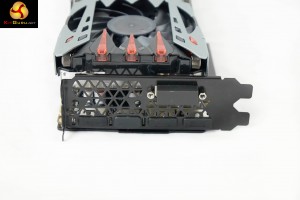
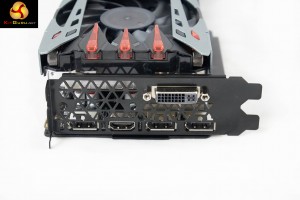
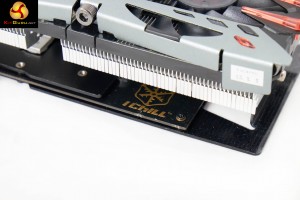
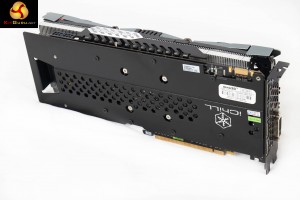
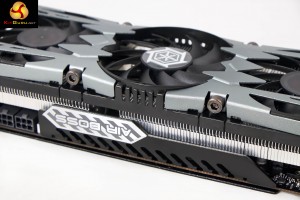
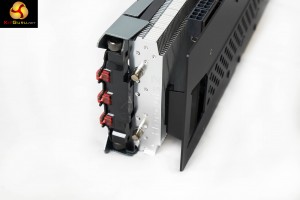
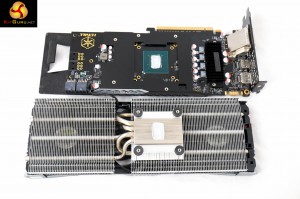
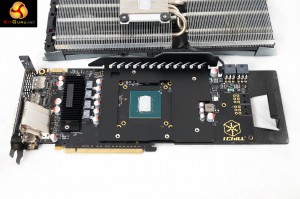
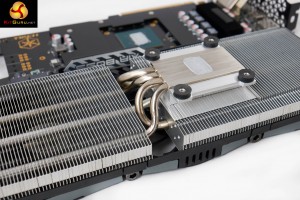
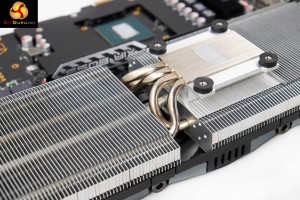
For the review today we are using Nvidia 347.25 drivers. We retested all Nvidia hardware with these drivers for this review, to keep things on a completely even footing. The AMD cards were retested with the Catalyst OMEGA 14.12 driver.
If you want to read more about our test system, or are interested in buying the same Kitguru Test Rig, check out our article with links on this page. We are using an Asus PB287Q monitor for this review today.
We test all the hardware today at high image quality settings and with anti aliasing when possible. Years ago gamers would have to make sacrifices to get smooth frame rates at 1080p – but it is 2015 and we all expect very high image quality even from these ‘mid range' boards. We include higher cost cards such as the R9 290 and GTX770 to get an idea of performance positioning in the market.
Comparison cards:
MSI GTX960 Gaming 2G OC (1,190mhz core / 1,753 mhz memory)
Palit GTX960 Super JetStream (1,279mhz core / 1800 mhz memory)
Asus GTX960 Strix OC Edition (1,253mhz core / 1800 mhz memory)
Asus R9 290 Direct CU II OC (1000 mhz core / 1,260 mhz memory)
Gigabyte GTX770 OC (1,137mhz core / 1,753 mhz memory)
Sapphire Dual X R9 285 (965 mhz core / 1,400 mhz memory)
XFX R9 280X DD (1,000 mhz core / 1,500 mhz memory)
Asus Direct CU II GTX 760 OC (1,006mhz core / 1,502mhz memory)
Asus GTX750TI Strix OC Edition (1,124mhz core / 1,350mhz memory)
Software:
Windows 7 Enterprise 64 bit
Unigine Heaven Benchmark
Unigine Valley Benchmark
3DMark Vantage
3DMark 11
3DMark
Fraps Professional
Steam Client
FurMark
Games:
Grid AutoSport
Tomb Raider
Metro Last Light Redux
Thief 201
Total War Rome 2: Emperor Edition
All the latest BIOS updates and drivers are used during testing. We perform generally under real world conditions, meaning KitGuru tests games across five closely matched runs and then average out the results to get an accurate median figure. If we use scripted benchmarks, they are mentioned on the relevant page.
Game descriptions edited with courtesy from Wikipedia.
Futuremark released 3DMark Vantage, on April 28, 2008. It is a benchmark based upon DirectX 10, and therefore will only run under Windows Vista (Service Pack 1 is stated as a requirement) and Windows 7. This is the first edition where the feature-restricted, free of charge version could not be used any number of times. 1280×1024 resolution was used with performance settings.
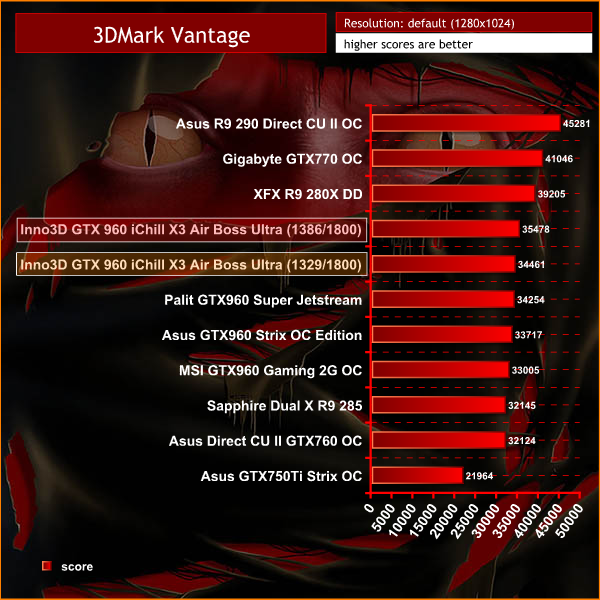
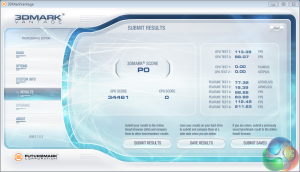
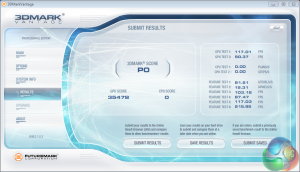
The Inno3D GeForce GTX 960 iChill X3 Air Boss Ultra takes top performance position among the GTX960 cards we have tested so far.
3DMark 11 is designed for testing DirectX 11 hardware running on Windows 7 and Windows Vista the benchmark includes six all new benchmark tests that make extensive use of all the new features in DirectX 11 including tessellation, compute shaders and multi-threading. After running the tests 3DMark gives your system a score with larger numbers indicating better performance. Trusted by gamers worldwide to give accurate and unbiased results, 3DMark 11 is the best way to test DirectX 11 under game-like loads.
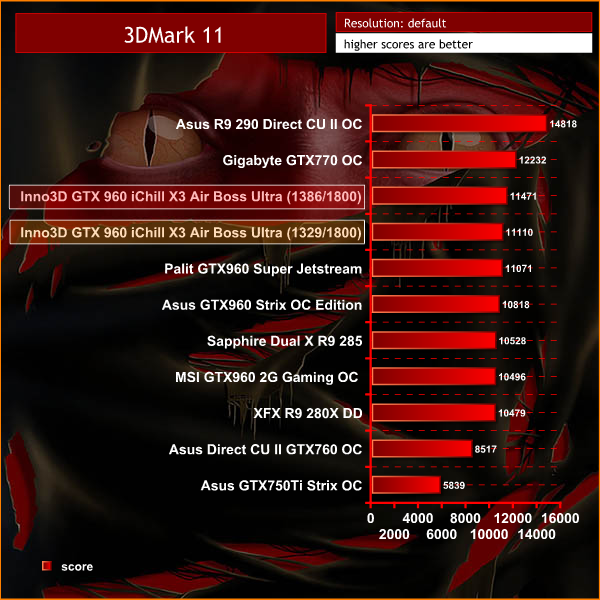
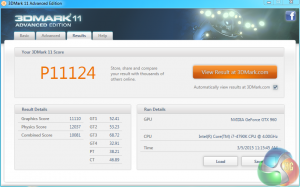
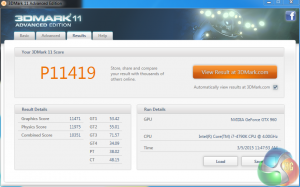
Impressive results, ahead of the Palit, Asus, and MSI GTX960 competitor cards.
3DMark is an essential tool used by millions of gamers, hundreds of hardware review sites and many of the world’s leading manufacturers to measure PC gaming performance.
Futuremark say “Use it to test your PC’s limits and measure the impact of overclocking and tweaking your system. Search our massive results database and see how your PC compares or just admire the graphics and wonder why all PC games don’t look this good.
To get more out of your PC, put 3DMark in your PC.”
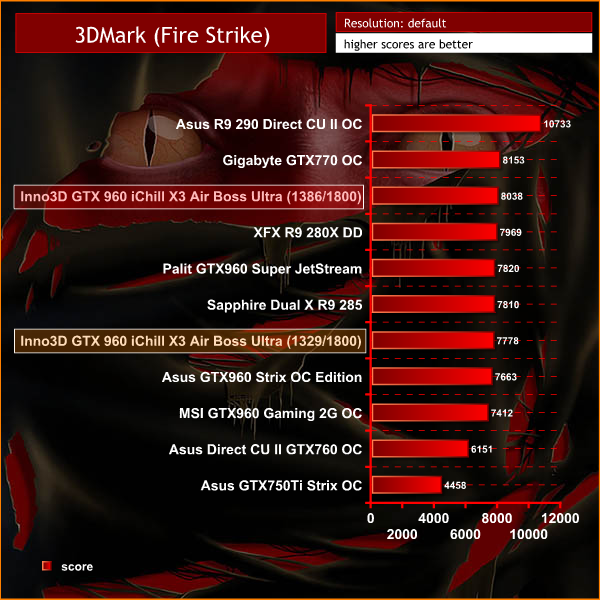
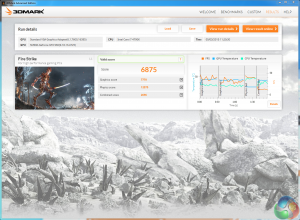
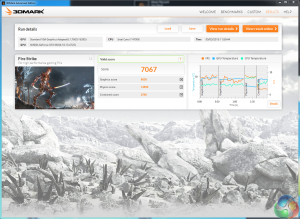
Out of the box speeds are very good, but when we overclock the Inno3D GeForce GTX 960 iChill X3 Air Boss Ultra to the limits we can see it isn't too far away from the Gigabyte GTX770 OC.Unigine provides an interesting way to test hardware. It can be easily adapted to various projects due to its elaborated software design and flexible toolset. A lot of their customers claim that they have never seen such extremely-effective code, which is so easy to understand.
Heaven Benchmark is a DirectX 11 GPU benchmark based on advanced Unigine engine from Unigine Corp. It reveals the enchanting magic of floating islands with a tiny village hidden in the cloudy skies. Interactive mode provides emerging experience of exploring the intricate world of steampunk. Efficient and well-architected framework makes Unigine highly scalable:
- Multiple API (DirectX 9 / DirectX 10 / DirectX 11 / OpenGL) render
- Cross-platform: MS Windows (XP, Vista, Windows 7) / Linux
- Full support of 32bit and 64bit systems
- Multicore CPU support
- Little / big endian support (ready for game consoles)
- Powerful C++ API
- Comprehensive performance profiling system
- Flexible XML-based data structures
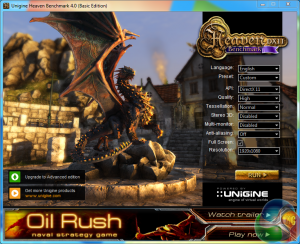
We set Quality to ‘Ultra', Tessellation to ‘Normal', Anti Aliasing to 4 times and the resolution to 1920×1080 (1080p).
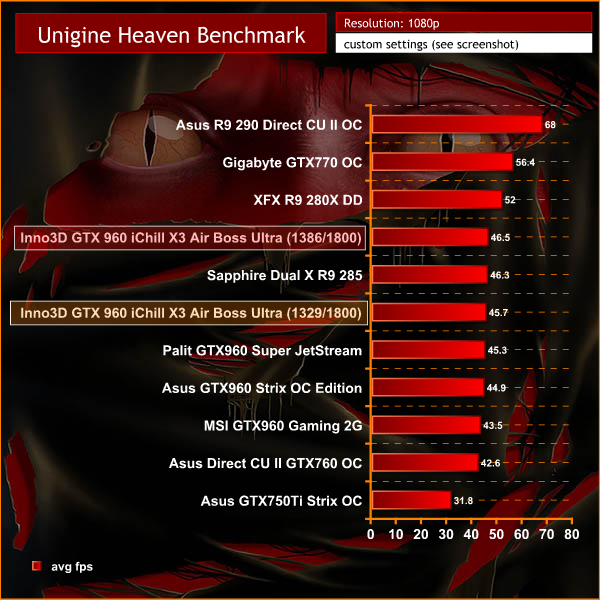
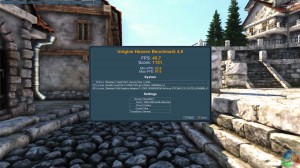
Performance is very closely matched against the Sapphire Dual X R9 285. When the Inno3D GeForce GTX 960 iChill X3 Air Boss Ultra is overclocked the performance manages to just edge out the R9 285.Tomb Raider received much acclaim from critics, who praised the graphics, the gameplay and Camilla Luddington’s performance as Lara with many critics agreeing that the game is a solid and much needed reboot of the franchise. Much criticism went to the addition of the multiplayer which many felt was unnecessary. Tomb Raider went on to sell one million copies in forty-eight hours of its release, and has sold 3.4 million copies worldwide so far. (Wikipedia).
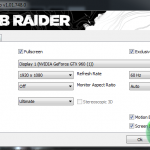
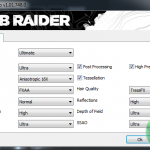
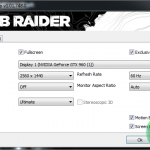
We test at both 1080p and 1440p with the ULTIMATE quality image profile enabled.
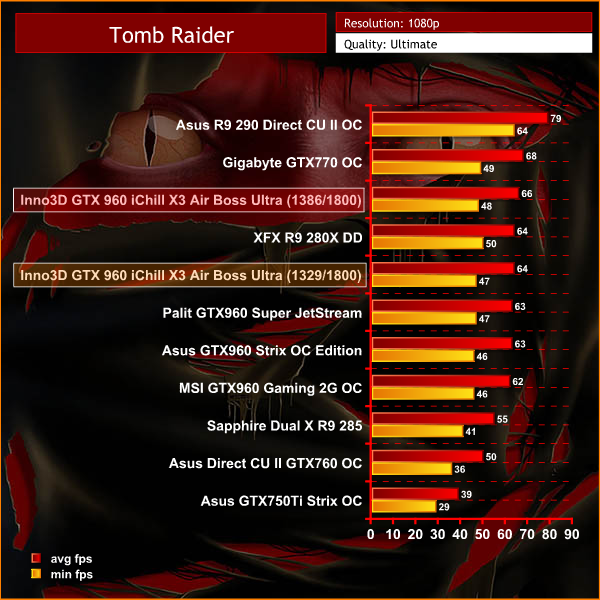
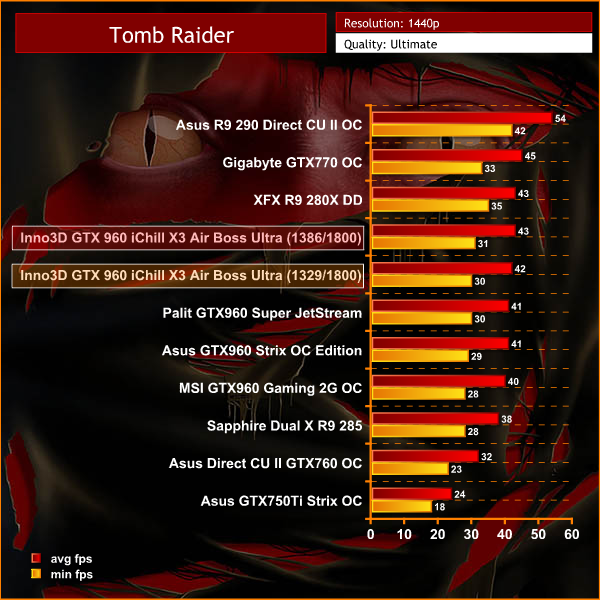
Tomb Raider is perfectly playable at both 1080p and 1440p at ‘Ultimate' image quality settings. Quite impressive for a sub £200 solution.
Grid Autosport (styled as GRID Autosport) is a racing video game by Codemasters and is the sequel to 2008′s Race Driver: Grid and 2013′s Grid 2. The game was released for Microsoft Windows, PlayStation 3 and Xbox 360 on June 24, 2014. (Wikipedia).

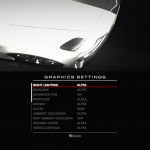
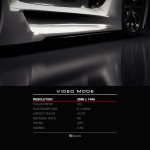
We test at both 1080p and 1440p, with the game engines ‘ULTRA' image quality profile and with 8 times Anti Aliasing enabled.

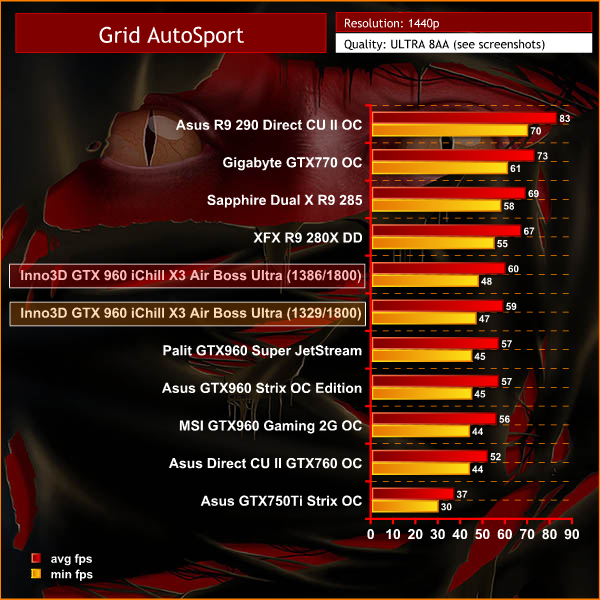
Good gameplay performance at both 1080p and 1440p resolutions. When overclocked, the frame rates increase proportionally.
Thief is set in a dark fantasy world inspired by Victorian, gothic, and steampunk aesthetics. Garrett, a master thief who has been away from his hometown for a long time, returns to it, a place known only as The City, and finds it ruled with an iron grip by a tyrant called The Baron. While The City is ravaged by a plague, the rich continue to live in isolation and good fortune while the poor are forming numerous mobs against the authorities, Garrett intends to use the volatile situation to his favor. (Wikipedia).
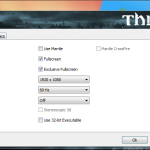
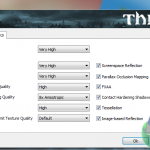

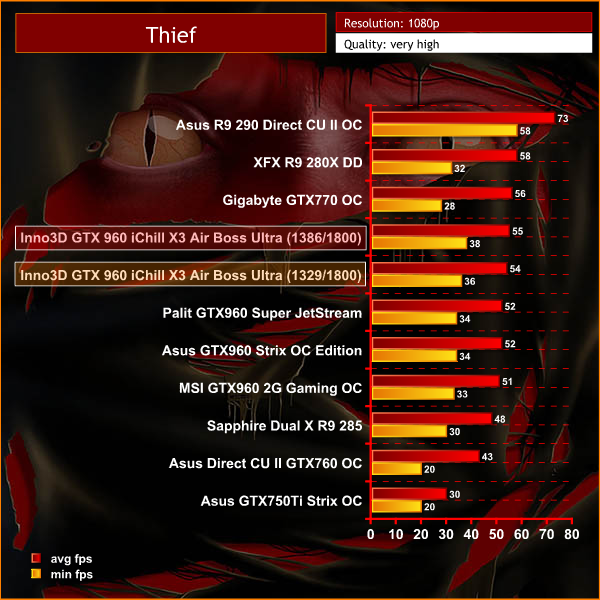
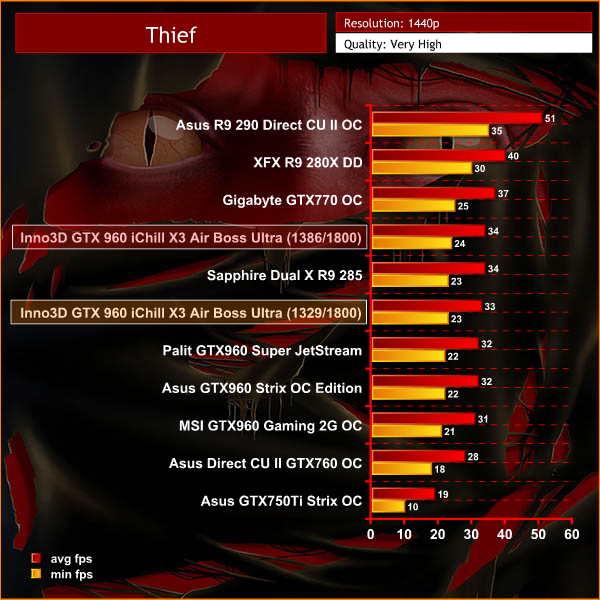
Thief is one of the more demanding engines on the market, even today. At 1080p the GTX960 cards can handle the engine fine, but at 1440p it is a tall ask and investing more money for a more powerful graphics solution would be advisable.
On May 22, 2014, a Redux version of Metro Last Light was announced. It was released on August 26, 2014 in North America and August 29, 2014 in Europe for the PC, PlayStation 4 and Xbox One. Redux adds all the DLC and graphical improvements. A compilation package, titled Metro Redux, was released at the same time which includes Last Light and 2033. (Wikipedia). We test with following settings: quality high, SSAA on, 16AF, Tessellation normal.
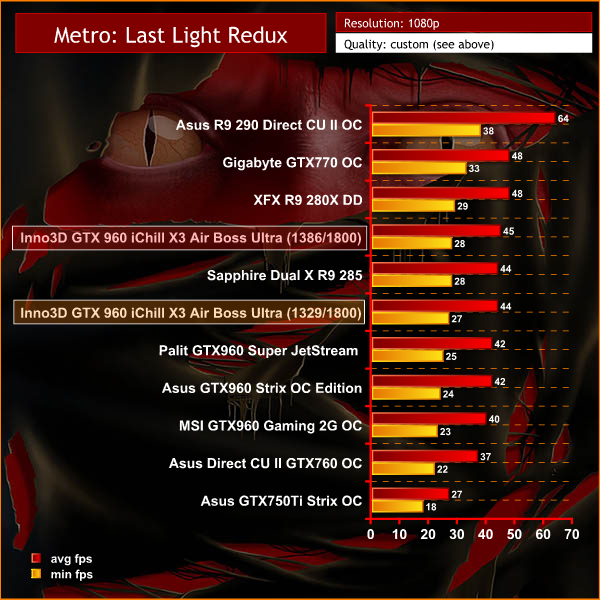
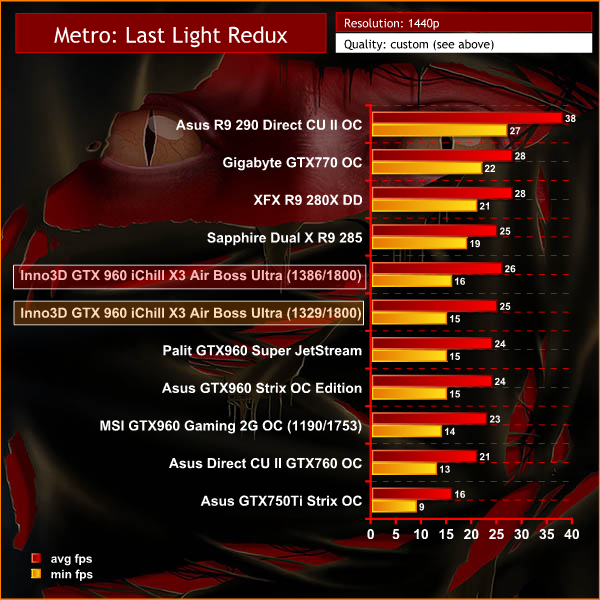
Another demanding engine, even at 1080p. Unless you were willing to reduce image quality settings you need to invest more money into the graphics hardware.
Total War: ROME II Emperor Edition. Emperor Edition collects together all free content to date, which includes wide-ranging revisions, additions to game features and adds a brand new Campaign Pack expansion, ‘Imperator Augustus’.
We test the game at 1080p with the image quality settings at the maximum – ‘EXTREME'. Unless we drop image quality settings noticeably, this game needs more powerful hardware to run smoothly at 1440p.
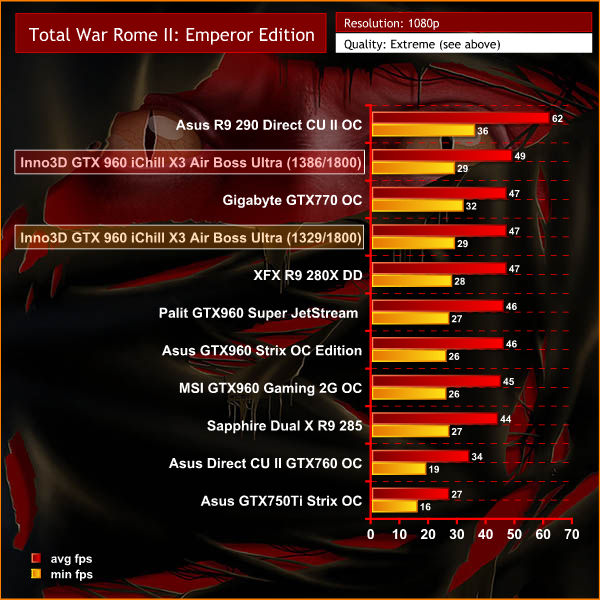
If you want solid 60+ frame rates then you will need to lower image quality, or invest in high end graphics solutions. To be fair, most people would be pleased with the performance from the Inno3D GeForce GTX 960 iChill X3 Air Boss Ultra.
The tests were performed in a controlled air conditioned room with temperatures maintained at a constant 23c – a comfortable environment for the majority of people reading this.Idle temperatures were measured after sitting at the desktop for 30 minutes. Load measurements were acquired by playing Crysis Warhead for 30 minutes and measuring the peak temperature. We also have included Furmark results, recording maximum temperatures throughout a 30 minute stress test. All fan settings were left on automatic.
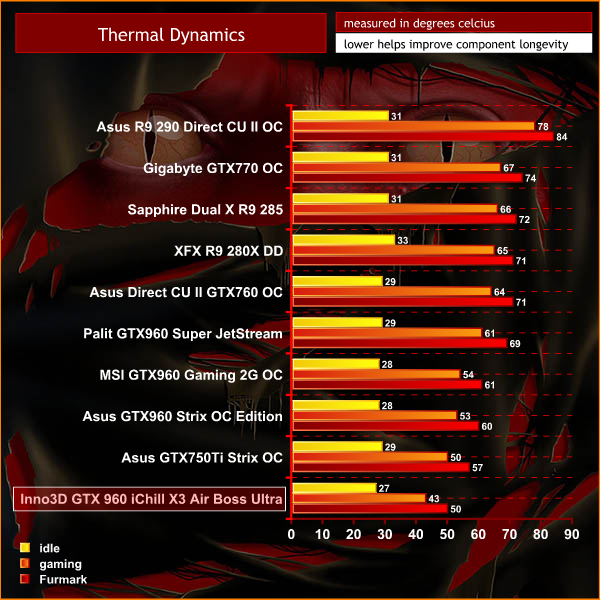
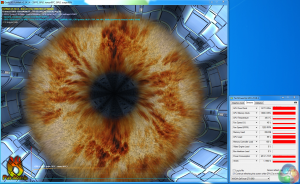
These are simply incredible results. The Inno3D GeForce GTX 960 iChill X3 Air Boss Ultra is by far the coolest running GTX960 we have tested. The previous leader, the Asus GTX960 Strix OC Edition runs 10c hotter!
We have built a system inside a Lian Li chassis with no case fans and have used a fanless cooler on our CPU. The motherboard is also passively cooled. This gives us a build with almost completely passive cooling and it means we can measure noise of just the graphics card inside the system when we run looped 3dMark tests.
We measure from a distance of around 1 meter from the closed chassis and 4 foot from the ground to mirror a real world situation. Ambient noise in the room measures close to the limits of our sound meter at 28dBa. Why do this? Well this means we can eliminate secondary noise pollution in the test room and concentrate on only the video card. It also brings us slightly closer to industry standards, such as DIN 45635.
KitGuru noise guide
10dBA – Normal Breathing/Rustling Leaves
20-25dBA – Whisper
30dBA – High Quality Computer fan
40dBA – A Bubbling Brook, or a Refrigerator
50dBA – Normal Conversation
60dBA – Laughter
70dBA – Vacuum Cleaner or Hairdryer
80dBA – City Traffic or a Garbage Disposal
90dBA – Motorcycle or Lawnmower
100dBA – MP3 player at maximum output
110dBA – Orchestra
120dBA – Front row rock concert/Jet Engine
130dBA – Threshold of Pain
140dBA – Military Jet takeoff/Gunshot (close range)
160dBA – Instant Perforation of eardrum
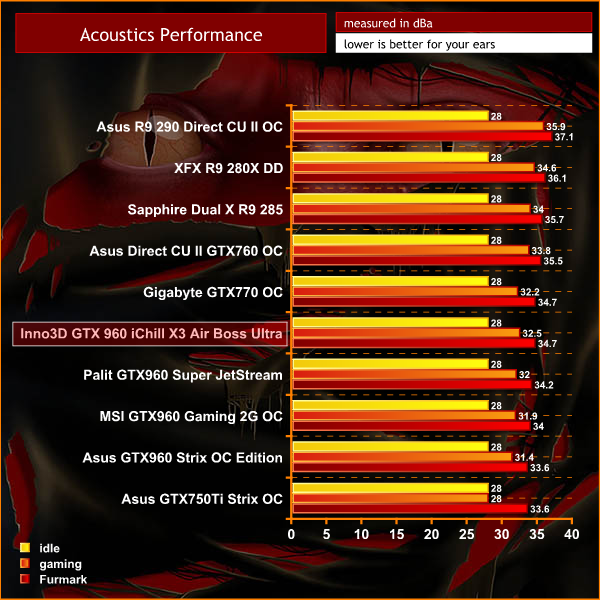
The Inno3D GeForce GTX 960 iChill X3 Air Boss Ultra is a quiet solution, barely audible when gaming, and likely to be masked out by several case fans.
We normally test power demand direct from the VGA card input, with our Keithley Integra unit. Today however we decided to go with a more traditional approach – measuring system wide load, minus the monitor. The system we are using for this review today is detailed HERE.
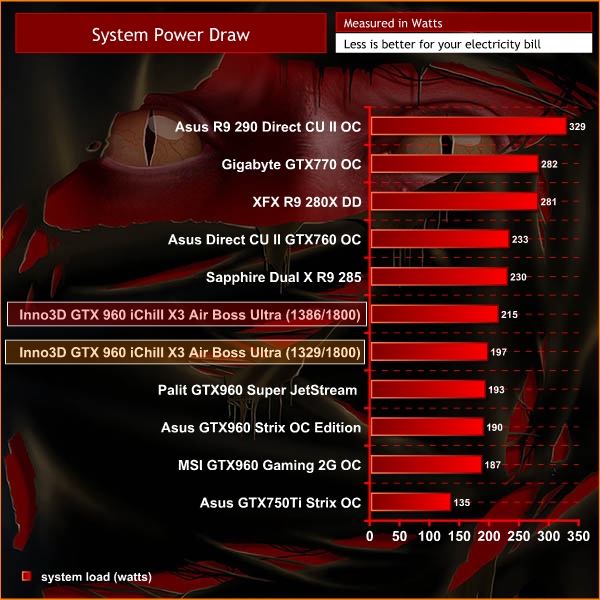
All of the GTX960 cards are efficient and the Inno3D GeForce GTX 960 iChill X3 Air Boss Ultra is no different. The full system consumes less than 200 watts under load.
Nvidia's mid range GTX960 may have launched almost a year after the first Maxwell based GTX750ti, but there are already several solutions from Nvidia partners that are worthy of some serious consideration.
The Inno3D GeForce GTX 960 iChill X3 Air Boss Ultra reviewed today is priced at £169.99 inc vat, and while it is the fastest GTX960 we have tested, it is also one of the least expensive. The Inno3D brand name may not have the exclusivity and appeal of an ASUS Republic of Gamers product, but on a technical level the Maxwell oriented Inno3D cards we have tested have been proficient, well designed and capable of performing at a similar level to leading products from market leaders.
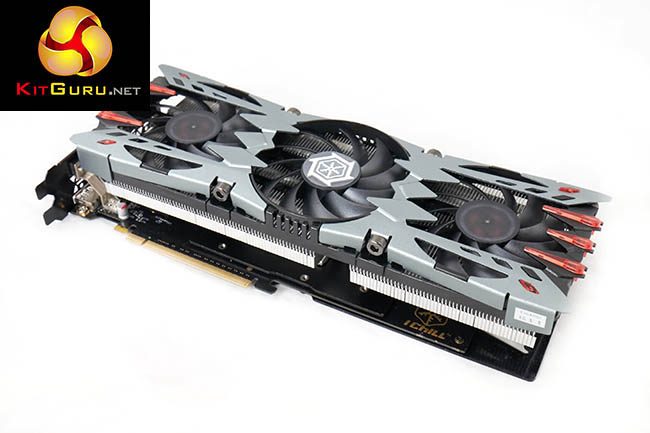
On an appearance level, I am not quite sure what to think. From various angles the card has a certain charm, however the extremely aggressive design can also look a little comical at times. When we reviewed the Inno3D GTX980 ‘iChill Herculez X4 Air Boss Ultra' back in October last year, our Facebook page confirmed my thoughts. Opinion was split … some readers loved it, others hated it.
Out of the box, the Inno3D is a performance monster, and faster than any other GTX960 we have tested. We managed to push the frame rates a little higher via software, but in reality, Inno3D have pushed this card close to the limits, as our modest tweaked 4.3% gains will attest.
One of the main reasons for buying the Inno3D GeForce GTX 960 iChill X3 Air Boss Ultra is related directly to the intimidating cooling solution. In a similar fashion to the Inno3D GTX980 model we reviewed, it is simply miles ahead of the coolers shipping on Gigabyte, MSI or ASUS cards. This in itself is no mean feat.

You can buy the Inno3D GeForce GTX 960 iChill X3 Air Boss Ultra from Overclockers UK for £169.99 inc vat. It is a fantastic solution shipping with one of the most ludicrous, pompous product names we can remember.
Discuss on our Facebook page, over HERE.
Pros:
- Maxwell architecture is very efficient.
- aggressive looking card.
- quiet under load.
- low power consumption.
- fastest GTX960 we have tested.
- solid performance at 1080p.
Cons:
- Many would consider it ugly.
Kitguru says: The Inno3D GeForce GTX 960 iChill X3 Air Boss Ultra will prove a silky smooth gaming experience at 1080p. It is also one of the coolest running gaming cards we have tested – hovering around 43c under load.

 KitGuru KitGuru.net – Tech News | Hardware News | Hardware Reviews | IOS | Mobile | Gaming | Graphics Cards
KitGuru KitGuru.net – Tech News | Hardware News | Hardware Reviews | IOS | Mobile | Gaming | Graphics Cards


